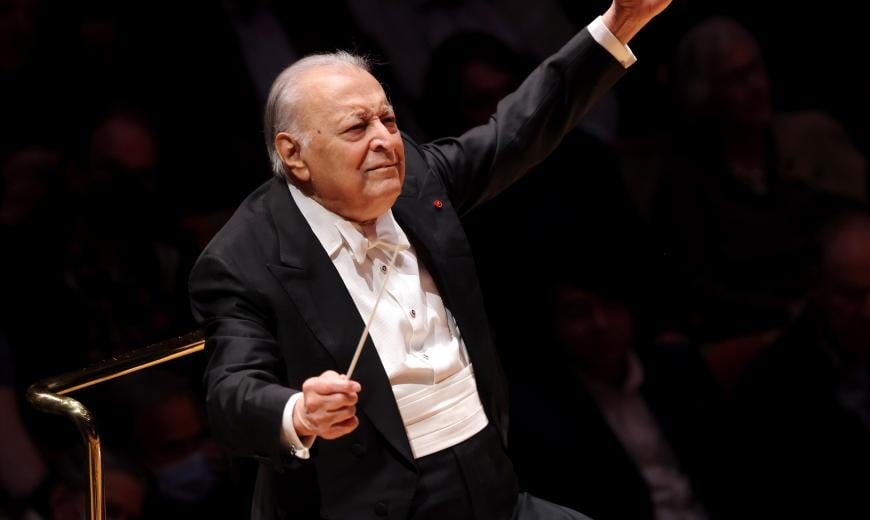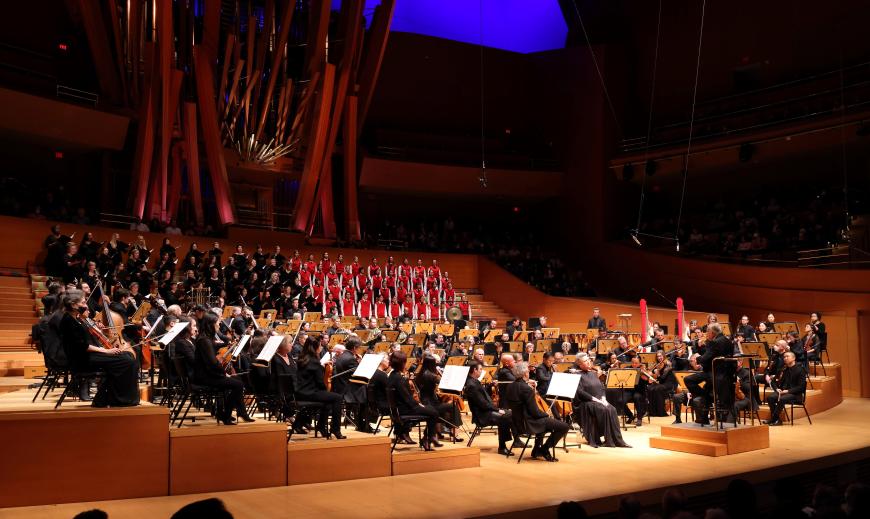
If you asked Zubin Mehta (who will celebrate his 87th birthday on April 29) why he chose to conduct Gustav Mahler’s massive Symphony No. 3 in D Minor to open his current series of concerts with the Los Angeles Philharmonic, his answer might be similar to Edmund Hillary’s famous response about why he climbed Mount Everest — “because it’s there.”
Thursday, after making his entrance to a standing ovation, Mehta gingerly made his way to the podium at Walt Disney Concert Hall, head held high, backbone ramrod straight, a baton in one hand, a cane in the other — every inch the old lion. And what a reign it’s been since 1962, when Mehta conducted his first season with the LA Phil at the age of 26. He is now the orchestra’s conductor emeritus. Once on the podium, he acknowledged the audience with a regal nod, assumed his seat (he can no longer conduct standing), waited for silence, raised his baton, and the great ascent of this musical Everest began.
Everything about Mahler’s Third Symphony is massive. Its instrumentation includes an armory’s worth of brass, winds, and percussion; the score also calls for an alto soloist, a full women’s chorus, and a children’s chorus. It has six movements, and it clocks in at around 100 minutes. The first movement alone is longer than Beethoven’s entire Fifth Symphony. Mahler himself referred to the symphony as a “monster.” What better way, then, for Mehta to show that he is still up to the challenge of competing in the heavyweight division of the orchestral arena?
Early in his career, Mehta was one of the most animated conductors in the business. His temperament was fiery, as were his testosterone-driven performances. And his favorite pyrotechnical composer was Mahler.
Now, as a battle-tested veteran, Mehta approaches the symphony not as a call to arms but as a deeply emotional journey. He conducts from memory, his former flamboyance replaced with subtle baton and hand indications. The members of the LA Phil know him so well, they’re able and eager to follow and give him what he wants.
In a letter of 1895, Mahler described the process of composing the symphony’s first movement as something of a runaway train. “It is terrible the way this movement keeps growing and expanding so far beyond anything I have ever composed before,” he wrote to his friend Natalie Bauer-Lechner. “It is so much, much bigger than life-size that everything human seems to shrink to pigmy size. I am seized with horror when I realize where all this is leading.”
Mahler envisioned the movement as a clash of tectonic proportions, where the death-like grip of winter (intoned in the opening theme by a chorus of eight horns) does battle with the life-affirming forces of spring, represented by a march. (The tempo direction for the movement is “Kräftig. Entschieden” — strong and decisive.)
Mahler also included touches of humor, writing to his friend and fellow conductor Bruno Walter that “those who can enjoy a good joke will find much to be amused by in the little promenades.”

Joyously, the next five sections are devoted to a celebration of nature, beginning with a Tempo di Menuetto — a memory-scape of interweaving birdcalls, marches, and jaunty country dances passed from strings to winds and brass until it all floats by with the lightness of passing clouds.
Perhaps intimidated by the shadow of Richard Wagner, Mahler never composed an opera. But his first four symphonies include song. And in the fourth movement, he introduces the amber hues of a female alto set to a pondering text drawn from Friedrich Nietzsche’s Thus Spake Zarathustra. Thursday, the solo was superbly sung by Gerhild Romberger, who pondered, “O man! What does the deep midnight say?”
Without pause, the mood turned playful with the women of the Los Angeles Master Chorale and the Los Angeles Children’s Chorus. The symphony resolves with one of Mahler’s rhapsodic masterpieces, an adagio that emerges entirely in the strings, casting a spell of serenity that leads to a classically Mahlerian timpani-pounding finale.
Leaving the stage after a tumultuous ovation, Mehta returned to acknowledge the soloists who played such an important role in the performance: concertmaster Martin Chalifour, principal trumpet Thomas Hooten (who performed the echoing offstage post horn solo on a C coronet), principal trombone David Rejano, and many others.
Then it was time to go home, which meant a short rest for Mehta, who would return at 11 a.m. the next day to climb Mahler’s Mount Everest again.




